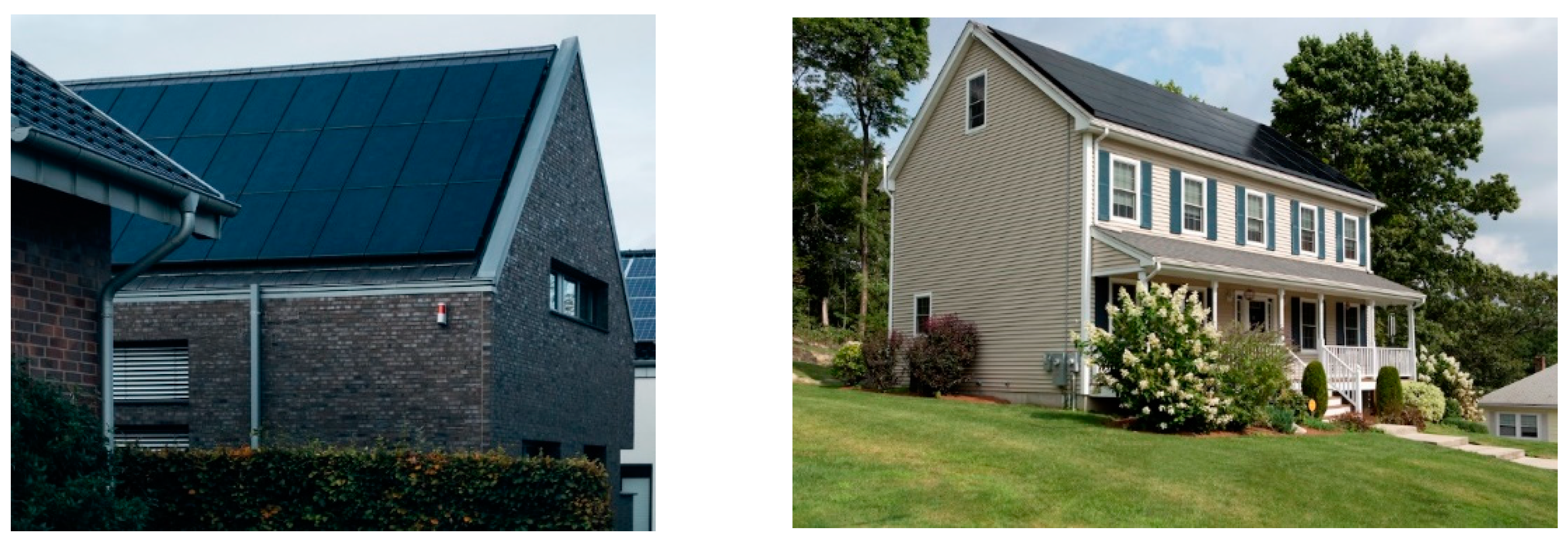Application of Building Integrated Photovoltaic (BIPV) in Net-Zero Energy Buildings (NZEBs)
Abstract
:1. Introduction
2. Net-Zero Energy Buildings (NZEBs)
2.1. Definition of NZEBs
2.2. Energy Sources in NZEBs
2.3. Solar Energy Application for NZEBs
3. Building Integrated Photovoltaics (BIPV)
3.1. Application on Roof
3.1.1. Roof Mounting PV System
3.1.2. Full Roof Solution
3.1.3. Solar Tiles and Slates
3.1.4. PV Membranes
3.2. Application on Façade
3.2.1. Photovoltaic Glass
3.2.2. Warm Façade
3.2.3. Cold Façade
3.3. Application as Shading
4. BIPV vs. BAPV
4.1. Comparison between BIPV and BAPV
4.2. Differences in Efficacy and Functionality
4.3. Social Impact
5. BIPV vs. External and Internal Shading
5.1. Difference in Efficacy and Functionality
5.2. Social Impact
6. Case Studies on BIPV on NZEBs
6.1. Singapore [121]
6.2. Brazil [124]
6.3. Alps [128]
6.4. Bern [128]
6.5. Japan [129]
6.6. Greece [130]
7. Tools and Guidelines to Design BIPV
7.1. Selection of Photovoltaic Modules
7.2. BIPV Structure Design
7.3. Inverter Selection
7.4. Grid Connection and Access
8. Discussion
- NZEBs are energy-efficient buildings dependent on sufficient renewable energy to meet as much energy the building consumes annually and have a significant impact on achieving carbon neutrality targets. NZEBs also aid in decreasing reliance on fossil energy sources by enhancing energy conservation within the building sector and fostering the generation of renewable energy to meet the operational needs of buildings.
- NZEBs may be reliant on both renewable energy sources and energy infrastructure, such as grid connectivity. Solar energy is deemed to be the most accessible energy source. Currently, on-site solar photovoltaic systems, due to their relatively low cost, dominate other renewable energy systems. BIPVs have numerous applications, such as roofs, facades, and shading systems. Additionally, BIPV can improve the esthetics and integrity of buildings while maximizing the efficiency of photovoltaic power generation due to its extensive installation area. Shading systems are usually required in buildings to minimize the energy usage of the HVAC system due to irradiation, and the combination of photovoltaic technology and shading systems is a perfect solution to increase energy efficiency. However, unlike conventional PV, BIPV photovoltaic modules are closely connected, which may increase surface temperature, thus affecting performance. Additionally, BIPV suffers from complex installation procedures, intensive maintenance, and high capital expenditure. Nevertheless, the utilization rate of BIPV is increasing year by year, saving energy, reducing emissions, and creating new employment opportunities.
- The case studies highlight that the ratio of building A/V, building envelope size, height, WWR, glass SHGC, light transmittance, and others have a significant impact on meeting the standards of NZEBs. A sole focus on roof-integrated PV may not be sufficient to accommodate the energy necessities of the building, thus shifting the attention towards the combination of BIPVs. Additionally, integrating BIPV and BIST can maximize energy utilization, converting the pathway to NZEBs easily. However, there are some shortcomings in the process of realizing NZEBs, such as a few analyses not considering indoor conditions, residents’ thermal comfort, and the shortage of monitoring systems for energy supply and demand.
- When designing BIPVs, it is necessary to comply with relevant standards and pay particular attention to the efficiency of power production, selection of PV modules and inverters, BIPV structure design, and grid-connected design. The design can be rationalized by studying the successful cases built and designed in layers (material design, module design, facade layer design, and the entire building). In the future, the photovoltaic power generation technology led by BIPV should continue to be developed to accelerate further the goal of achieving net zero energy consumption.
Author Contributions
Funding
Data Availability Statement
Conflicts of Interest
References
- Chua, K.J.; Chou, S.K.; Yang, W.M.; Yan, J. Achieving better energy-efficient air conditioning—A review of technologies and strategies. Appl. Energy 2013, 104, 87–104. [Google Scholar] [CrossRef]
- Chen, L.; Msigwa, G.; Yang, M.; Osman, A.I.; Fawzy, S.; Rooney, D.W.; Yap, P.S. Strategies to achieve a carbon neutral society: A review. Environ. Chem. Lett. 2022, 20, 2277–2310. [Google Scholar] [CrossRef] [PubMed]
- Chen, L.; Huang, L.; Hua, J.; Chen, Z.; Wei, L.; Osman, A.I.; Fawzy, S.; Rooney, D.W.; Dong, L.; Yap, P.S. Green construction for low-carbon cities: A review. Environ. Chem. Lett. 2023, 21, 1627–1657. [Google Scholar] [CrossRef]
- Howlett, R.J.; Jain, L.C.; Lee, S.H. Sustainability in energy and buildings: Results. In Proceedings of the International Conference on Sustainability in Energy and Buildings (SEB’10), Brighton, UK, 6–7 May 2010. [Google Scholar]
- Sartori, I.; Napolitano, A.; Voss, K. Net zero energy buildings: A consistent definition framework. Energy Build. 2012, 48, 220–232. [Google Scholar] [CrossRef]
- Recast, E. Directive 2010/31/EU of the European Parliament and of the Council of 19 May 2010 on the energy performance of buildings (recast). Off. J. Eur. Union 2010, 18, 2010. [Google Scholar]
- European Commission. Low Energy Buildings in Europe: Current State of Play, Definitions and Best Practice; European Commission: Brussels, Belgium, 2009. [Google Scholar]
- DOE. Building Technologies Program, Planned Program Activities for 2008–2012; Department of Energy United States: Washington, DC, USA, 2008.
- Bouckaert, S.; Pales, A.F.; McGlade, C.; Remme, U.; Wanner, B.; Varro, L.; D’Ambrosio, D.; Spencer, T. Net Zero by 2050: A Roadmap for the Global Energy Sector; International Energy Agency: Paris, France, 2021.
- Peng, C.; Huang, Y.; Wu, Z. Building-integrated photovoltaics (BIPV) in architectural design in China. Energy Build. 2011, 43, 3592–3598. [Google Scholar] [CrossRef]
- Ohene, E.; Chan, A.P.C.; Darko, A. Review of global research advances towards net-zero emissions buildings. Energy Build. 2022, 266, 112142. [Google Scholar] [CrossRef]
- Wu, W.; Skye, H.M. Residential net-zero energy buildings: Review and perspective. Renew. Sustain. Energy Rev. 2021, 142, 110859. [Google Scholar] [CrossRef] [PubMed]
- Wells, L.; Rismanchi, B.; Aye, L. A review of Net Zero Energy Buildings with reflections on the Australian context. Energy Build. 2018, 158, 616–628. [Google Scholar] [CrossRef]
- UK Energy Efficiency Action Plan; DEFRA: London, UK, 2007.
- Crawley, D.; Pless, S.; Torcellini, P. Getting to Net Zero; National Renewable Energy Lab. (NREL): Golden, CO, USA, 2009.
- Lützkendorf, T.; Frischknecht, R. (Net-) zero-emission buildings: A typology of terms and definitions. Build. Cities 2020, 1, 662–675. [Google Scholar] [CrossRef]
- Barbuzza, E.; Buceti, G.; Pozio, A.; Santarelli, M.; Tosti, S. Gasification of wood biomass with renewable hydrogen for the production of synthetic natural gas. Fuel 2019, 242, 520–531. [Google Scholar] [CrossRef]
- Marszal, A.J.; Heiselberg, P.; Bourrelle, J.S.; Musall, E.; Voss, K.; Sartori, I.; Napolitano, A. Zero Energy Building—A review of definitions and calculation methodologies. Energy Build. 2011, 43, 971–979. [Google Scholar] [CrossRef]
- Zhou, Z.; Feng, L.; Zhang, S.; Wang, C.; Chen, G.; Du, T.; Li, Y.; Zuo, J. The operational performance of “net zero energy building”: A study in China. Appl. Energy 2016, 177, 716–728. [Google Scholar] [CrossRef]
- Barbose, G.L.; Darghouth, N.R.; Millstein, D.; LaCommare, K.; Di Santi, N.; Widiss, R. Tracking the Sun 10: The Installed Price of Residential and Non-Residential Photovoltaic Systems in the United States article 2017. Available online: http://login.ez.xjtlu.edu.cn/login?url=https://search.ebscohost.com/login.aspx?direct=true&db=edssch&AN=edssch.oai%3aescholarship.org%3aark%3a%2f13030%2fqt5h90b3j4&site=eds-live&scope=site (accessed on 21 August 2022).
- Barbose, G.L.; Darghouth, N.R.; LaCommare, K.H.; Millstein, D.; Rand, J. Tracking the Sun: Installed Price Trends for Distributed Photovoltaic Systems in The United States—2018 edition; Lawrence Berkeley National Lab. (LBNL): Berkeley, CA, USA, 2018.
- Musall, E.; Weiss, T.; Voss, K.; Lenoir, A.; Garde, F. Net Zero Energy Solar Buildings: An Overview and Analysis on Worldwide Building Projects. In Proceedings of the EuroSun Conference 2010, Graz, Austria, 28 September–1 October 2010. [Google Scholar]
- Yang, H.; Burnett, J.; Ji, J. Simple approach to cooling load component calculation through PV walls. Energy Build. 2000, 31, 285–290. [Google Scholar] [CrossRef]
- Nibandhe, A.; Bonyadi, N.; Rounis, E.; Lee, B.; Athienitis, A.; Bagchi, A. Design of a coupled BIPV/T-solid desiccant cooling system for a warm and humid climate. In Proceedings of the ISES Solar World Congress 2019 and IEA SHC International Conference on Solar Heating and Cooling for Buildings and Industry, Santiago, Chile, 4–7 November 2019. [Google Scholar]
- Agrawal, B.; Tiwari, G.N. Optimizing the energy and exergy of building integrated photovoltaic thermal (BIPVT) systems under cold climatic conditions. Appl. Energy 2010, 87, 417–426. [Google Scholar] [CrossRef]
- Bahaj, A.S.; James, P.A.B.; Jentsch, M.F. Potential of emerging glazing technologies for highly glazed buildings in hot arid climates. Energy Build. 2008, 40, 720–731. [Google Scholar] [CrossRef]
- Qiu, C.; Yang, H.; Zhang, W. Investigation on the energy performance of a novel semi-transparent BIPV system integrated with vacuum glazing. Build. Simul. 2019, 12, 29–39. [Google Scholar] [CrossRef]
- D’Agostino, D.; Mazzella, S.; Minelli, F.; Minichiello, F. Obtaining the NZEB target by using photovoltaic systems on the roof for multi-storey buildings. Energy Build. 2022, 267, 112147. [Google Scholar] [CrossRef]
- Peng, J.; Lu, L.; Yang, H.; Han, J. Investigation on the annual thermal performance of a photovoltaic wall mounted on a multi-layer façade. Appl. Energy 2013, 112, 646–656. [Google Scholar] [CrossRef]
- Rounis, E.D.; Athienitis, A.; Stathopoulos, T. Review of air-based PV/T and BIPV/T systems—Performance and modelling. Renew. Energy 2021, 163, 1729–1753. [Google Scholar] [CrossRef]
- Fong, K.F.; Lee, C.K. Towards net zero energy design for low-rise residential buildings in subtropical Hong Kong. Appl. Energy 2012, 93, 686–694. [Google Scholar] [CrossRef]
- Hassoun, A.; Dincer, I. Analysis and performance assessment of a multigenerational system powered by Organic Rankine Cycle for a net zero energy house. Appl. Therm. Eng. 2015, 76, 25–36. [Google Scholar] [CrossRef]
- Good, C.; Andresen, I.; Hestnes, A.G. Solar energy for net zero energy buildings—A comparison between solar thermal, PV and photovoltaic–thermal (PV/T) systems. Sol. Energy 2015, 122, 986–996. [Google Scholar] [CrossRef]
- Ballarini, I.; De Luca, G.; Paragamyan, A.; Pellegrino, A.; Corrado, V. Transformation of an office building into a nearly zero energy building (NZEB): Implications for thermal and visual comfort and energy performance. Energies 2019, 12, 895. [Google Scholar] [CrossRef]
- Jiang, W.; Ju, Z.; Tian, H.; Liu, Y.; Arıcı, M.; Tang, X.; Li, Q.; Li, D.; Qi, H. Net-zero energy retrofit of rural house in severe cold region based on passive insulation and BAPV technology. J. Clean. Prod. 2022, 360, 132198. [Google Scholar] [CrossRef]
- Perez-Mora, N.; Bava, F.; Andersen, M.; Bales, C.; Lennermo, G.; Nielsen, C.; Furbo, S.; Martínez-Moll, V. Solar district heating and cooling: A review. Int. J. Energy Res. 2018, 42, 1419–1441. [Google Scholar] [CrossRef]
- Herrando, M.; Ramos, A. Photovoltaic-Thermal (PV-T) Systems for Combined Cooling, Heating and Power in Buildings: A Review. Energies 2022, 15, 3021. [Google Scholar] [CrossRef]
- Herrando, M.; Pantaleo, A.M.; Wang, K.; Markides, C.N. Solar combined cooling, heating and power systems based on hybrid PVT, PV or solar-thermal collectors for building applications. Renew. Energy 2019, 143, 637–647. [Google Scholar] [CrossRef]
- Misara, S.; Pornnimit, A. Mechanical characteristics of BIPV modules under different load scenarios and encaplsuations. In Proceedings of the International Solar Energy Society-ISES-30th ISES Biennial Solar World Congress 2011, Kassel, Germany, 28 August–2 September 2011; pp. 2193–2203. [Google Scholar]
- Sinha, A.; Sulas-Kern, D.B.; Owen-Bellini, M.; Spinella, L.; Uličná, S.; Pelaez, S.A.; Johnston, S.; Schelhas, L.T. Glass/glass photovoltaic module reliability and degradation: A review. J. Phys. D Appl. Phys. 2021, 54, 413002. [Google Scholar] [CrossRef]
- Zhang, C.; Ji, J.; Wang, C.; Ke, W.; Xie, H.; Yu, B. Experimental and numerical studies on the thermal and electrical performance of a CdTe ventilated window integrated with vacuum glazing. Energy 2022, 244, 123128. [Google Scholar] [CrossRef]
- Peng, J.; Curcija, D.C.; Thanachareonkit, A.; Lee, E.S.; Goudey, H.; Jonsson, J.; Selkowitz, S.E. Comparative study on the overall energy performance between photovoltaic and Low-E insulated glass units. Sol. Energy 2021, 214, 443–456. [Google Scholar] [CrossRef]
- Rezk, H.; Al-Oran, M.; Gomaa, M.R.; Tolba, M.A.; Fathy, A.; Abdelkareem, M.A.; Olabi, A.; El-Sayed, A.H.M. A novel statistical performance evaluation of most modern optimization-based global MPPT techniques for partially shaded PV system. Renew. Sustain. Energy Rev. 2019, 115, 109372. [Google Scholar] [CrossRef]
- Radziemska, E. The effect of temperature on the power drop in crystalline silicon solar cells. Renew. Energy 2013, 28, 1–12. [Google Scholar] [CrossRef]
- Maghrabie, H.M.; Abdelkareem, M.A.; Al-Alami, A.H.; Ramadan, M.; Mushtaha, E.; Wilberforce, T.; Olabi, A.G. State-of-the-art technologies for building-integrated photovoltaic systems. Buildings 2021, 11, 383. [Google Scholar] [CrossRef]
- Jiang, T.; Zhang, G.; Xia, R.; Huang, J.; Li, X.; Wang, M.; Yip, H.-L.; Cao, Y. Semitransparent organic solar cells based on all-low-bandgap donor and acceptor materials and their performance potential. Mater. Today Energy 2021, 21, 100807. [Google Scholar] [CrossRef]
- Hire, P.; Kokane, M.; Gaikwad, S.; Bhople, S.; Balte, S. Solar Tiles as Rooftop. Bull. Monum. 2020, 21. [Google Scholar]
- Babatunde, A.; Abbasoglu, S.; Senol, M. Analysis of the impact of dust, tilt angle and orientation on performance of PV Plants. Renew. Sustain. Energy Rev. 2018, 90, 1017–1026. [Google Scholar] [CrossRef]
- Muehleisen, W.; Loeschnig, J.; Feichtner, M.; Burgers, A.; Bende, E.; Zamini, S.; Yerasimou, Y.; Kosel, J.; Hirschl, C.; Georghiou, G. Energy yield measurement of an elevated PV system on a white flat roof and a performance comparison of monofacial and bifacial modules. Renew. Energy 2021, 170, 613–619. [Google Scholar] [CrossRef]
- Jopen, B. The Future Is Renewable. 2020. Available online: https://unsplash.com/photos/p2GuLUu79Rg (accessed on 15 August 2022).
- Solar, V. Vivint Solar—Solar Panels on a Beautiful Home with Green Lawn and Bushes. 2020. Available online: https://unsplash.com/photos/g1QkXQ1EJ-w (accessed on 15 August 2022).
- Urbanetz, J.; Zomer, C.D.; Rüther, R. Compromises between form and function in grid-connected, building-integrated photovoltaics (BIPV) at low-latitude sites. Build. Environ. 2011, 46, 2107–2113. [Google Scholar] [CrossRef]
- Frontini, F.; Bonomo, P.; Chatzipanagi, A.; Verberne, G.; van den Donker, M.; Sinapis, K.; Folkerts, W. BIPV Product Overview for Solar Facades and Roofs; Solar Energy Application Centre: Eindhoven, The Netherlands, 2015. [Google Scholar]
- Madessa, H.B. Performance Analysis of Roof-mounted Photovoltaic Systems—The Case of a Norwegian Residential Building. Energy Procedia 2015, 83, 474–483. [Google Scholar] [CrossRef]
- Agathokleous, R.; Kalogirou, S.A. Thermal analysis of a building integrated photovoltaic (BIPV) system. In Proceedings of the 29th International Conference on Efficiency, Cost, Optimization, Simulation and Environmental Impact of Energy Systems, Portoroz, Slovenia, 19–23 June 2016; 2016. [Google Scholar]
- Vats, K.; Tiwari, G. Performance evaluation of a building integrated semitransparent photovoltaic thermal system for roof and façade. Energy Build. 2012, 45, 211–218. [Google Scholar] [CrossRef]
- Saadon, S.; Gaillard, L.; Giroux-Julien, S.; Ménézo, C. Simulation study of a naturally-ventilated building integrated photovoltaic/thermal (BIPV/T) envelope. Renew. Energy 2016, 87, 517–531. [Google Scholar] [CrossRef]
- Solar, V. Vivint Solar—Solar Panels on Small Home with Driveway from Street. 2020. Available online: https://unsplash.com/photos/HASgVRE48KY (accessed on 20 August 2022).
- Solar, V. Vivint Solar—Solar Panels on Home with Bushes in Backyard. 2019. Available online: https://unsplash.com/photos/ZEiFiOsV3K4 (accessed on 20 August 2022).
- Probst, M.C.M.; Roecker, C. Criteria and policies to master the visual impact of solar systems in urban environments: The LESO-QSV method. Sol. Energy 2019, 184, 672–687. [Google Scholar] [CrossRef]
- Devetaković, M.; Djordjević, D.; Radojević, M.; Krstić-Furundžić, A.; Burduhos, B.-G.; Martinopoulos, G.; Neagoe, M.; Lobaccaro, G. Photovoltaics on Landmark Buildings with Distinctive Geometries. Appl. Sci. 2020, 10, 6696. [Google Scholar] [CrossRef]
- Bahaj, A.S. Photovoltaic roofing: Issues of design and integration into buildings. Renew. Energy 2003, 28, 2195–2204. [Google Scholar] [CrossRef]
- Panchenko, V.A. Solar Roof Panels for Electric and Thermal Generation. Appl. Sol. Energy 2018, 54, 350–353. [Google Scholar] [CrossRef]
- León, E.Z.; de Cuenca, U.; Barraza, C.C. Adaptability of photovoltaic mono-polycrystalline solar panels and photovoltaic roof tiles on dwelling roofs of real estate developments. Rev. Construcción J. Constr. 2019, 18, 42–53. [Google Scholar] [CrossRef]
- NKumar, N.M.; Sudhakar, K.; Samykano, M. Performance of thin-film BIPV as double sloped pitched roof in buildings of Malaysia. Energy Sources Part A Recover. Util. Environ. Eff. 2018, 40, 2476–2484. [Google Scholar]
- Kurz, D.; Nawrowski, R. Thermal Time Constant of PV Roof Tiles Working under Different Conditions. Appl. Sci. 2019, 9, 1626. [Google Scholar] [CrossRef]
- Gan, G. Effect of air gap on the performance of building-integrated photovoltaics. Energy 2009, 34, 913–921. [Google Scholar] [CrossRef]
- New Roof. Available online: https://www.tegola-solare.com/en/solar-hybrid-tile.php (accessed on 21 August 2022).
- Fornace Fonti. Available online: https://www.fornacefonti.it/en (accessed on 21 August 2022).
- Feurer, T.; Reinhard, P.; Avancini, E.; Bissig, B.; Löckinger, J.; Fuchs, P.; Carron, R.; Weiss, T.P.; Perrenoud, J.; Stutterheim, S.; et al. Progress in thin film CIGS photovoltaics—Research and development, manufacturing, and applications. Prog. Photovolt. Res. Appl. 2017, 25, 645–667. [Google Scholar] [CrossRef]
- Fthenakis, V. Sustainability of photovoltaics: The case for thin-film solar cells. Renew. Sustain. Energy Rev. 2009, 13, 2746–2750. [Google Scholar] [CrossRef]
- Leo, K. Organic photovoltaics. Nat. Rev. Mater. 2016, 1, 110678. [Google Scholar] [CrossRef]
- Li, Q.; Zanelli, A. A review on fabrication and applications of textile envelope integrated flexible photovoltaic systems. Renew. Sustain. Energy Rev. 2021, 139, 110678. [Google Scholar] [CrossRef]
- Weka Daksystemen, B.V. Available online: https://www.wekadaksystemen.nl/powerflex.html (accessed on 23 August 2022).
- Yu, G.; Yang, H.; Luo, D.; Cheng, X.; Ansah, M.K. A review on developments and researches of building integrated photovoltaic (BIPV) windows and shading blinds. Renew. Sustain. Energy Rev. 2021, 149, 111355. [Google Scholar] [CrossRef]
- Chen, X.; Yang, H.; Peng, J. Energy optimization of high-rise commercial buildings integrated with photovoltaic facades in urban context. Energy 2019, 172, 1–17. [Google Scholar] [CrossRef]
- Gorgolis, G.; Karamanis, D. Solar energy materials for glazing technologies. Sol. Energy Mater. Sol. Cells 2016, 144, 559–578. [Google Scholar] [CrossRef]
- Cuce, E. Toward multi-functional PV glazing technologies in low/zero carbon buildings: Heat insulation solar glass—Latest developments and future prospects. Renew. Sustain. Energy Rev. 2016, 60, 1286–1301. [Google Scholar] [CrossRef]
- Energyglass. Available online: https://energyglass.gruppostg.com/en/photovoltaic-elements/photovoltaic-glass.html (accessed on 23 August 2022).
- Lopez, C.P.; Frontini, F.; Bonomo, P.; Scognamiglio, A. PV and façade systems for the building skin. Analysis of design effectiveness and technological features. In Proceedings of the 29th European Photovoltaic Solar Energy Conference and Exhibition, Amsterdam, The Netherlands, 22–26 September 2014; pp. 3613–3618. [Google Scholar]
- Deplazes, A. Available online: https://www.wicona.com/pt/product-launch/references/switzerland/monte-rosa-hut/ (accessed on 25 August 2022).
- Corti, P.; Capannolo, L.; Bonomo, P.; De Berardinis, P.; Frontini, F. Comparative Analysis of BIPV Solutions to Define Energy and Cost-Effectiveness in a Case Study. Energies 2020, 13, 3827. [Google Scholar] [CrossRef]
- BIPV. Available online: https://www.bipv.ch/index.php/en/ (accessed on 27 August 2022).
- Krarti, M. Evaluation of PV integrated sliding-rotating overhangs for US apartment buildings. Appl. Energy 2021, 293, 116942. [Google Scholar] [CrossRef]
- Jayathissa, P.; Luzzatto, M.; Schmidli, J.; Hofer, J.; Nagy, Z.; Schlueter, A. Optimising building net energy demand with dynamic BIPV shading. Appl. Energy 2017, 202, 726–735. [Google Scholar] [CrossRef]
- Allouhi, A.; Rehman, S.; Buker, M.S.; Said, Z. Up-to-date literature review on Solar PV systems: Technology progress, market status and R&D. J. Clean. Prod. 2022, 362, 132339. [Google Scholar] [CrossRef]
- Jacobson, Z.M. Review of solutions to global warming, air pollution, and energy security. Energy Environ. Sci. 2009, 2, 148–173. [Google Scholar] [CrossRef]
- Singh, D.; Chaudhary, R.; Karthick, A. Review on the progress of building-applied/integrated photovoltaic system. Environ. Sci. Pollut. Res. 2021, 28, 47689–47724. [Google Scholar] [CrossRef]
- Zhang, T.; Wang, M.; Yang, H. A Review of the Energy Performance and Life-Cycle Assessment of Building-Integrated Photovoltaic (BIPV) Systems. Energies 2018, 11, 3157. [Google Scholar] [CrossRef]
- Park, K.; Kang, G.; Kim, H.; Yu, G.; Kim, J. Analysis of thermal and electrical performance of semi-transparent photovoltaic (PV) module. Energy 2010, 35, 2681–2687. [Google Scholar] [CrossRef]
- Righini, G.C.; Enrichi, F. Solar cells’ evolution and perspectives: A short review. In Solar Cells and Light Management; Elsevier: Amsterdam, The Netherlands, 2020; pp. 1–32. [Google Scholar]
- Reddy, P.; Gupta, M.V.N.S.; Nundy, S.; Karthick, A.; Ghosh, A. Status of BIPV and BAPV System for Less Energy-Hungry Building in India—A Review. Appl. Sci. 2020, 10, 2337. [Google Scholar] [CrossRef]
- Zhu, Q.; Si, L.; Jiang, T. Economical and environmental analysis of building photovoltaic systems with different installation styles. Acta Energiae Solaris Sin. 2012, 33, 24–29. [Google Scholar]
- Kaplanis, S.; Kaplani, E.; Kaldellis, J. PV temperature and performance prediction in free-standing, BIPV and BAPV incorporating the effect of temperature and inclination on the heat transfer coefficients and the impact of wind, efficiency and ageing. Renew. Energy 2021, 181, 235–249. [Google Scholar] [CrossRef]
- Bellia, L.; Marino, C.; Minichiello, F.; Pedace, A. An Overview on Solar Shading Systems for Buildings. Energy Procedia 2014, 62, 309–317. [Google Scholar] [CrossRef]
- Gupta, V.; Sharma, M.; Pachauri, R.K.; Babu, K.D. Comprehensive review on effect of dust on solar photovoltaic system and mitigation techniques. Sol. Energy 2019, 191, 596–622. [Google Scholar] [CrossRef]
- Celik, A.N. Long-term energy output estimation for photovoltaic energy systems using synthetic solar irradiation data. Energy 2003, 28, 479–493. [Google Scholar] [CrossRef]
- Amritanshu, S.; Karunesh, K.; Sharma, A.; Biwole, P.H. Cooling methodologies of photovoltaic module for enhancing electrical efficiency: A review. Sol. Energy Mater. Sol. Cells 2017, 160, 275–286. [Google Scholar]
- Lamnatou, C.; Chemisana, D. Photovoltaic/thermal (PVT) systems: A review with emphasis on environmental issues. Renew. Energy 2017, 105, 270–287. [Google Scholar] [CrossRef]
- Nahar, A.; Hasanuzzaman, M.; Rahim, N.A. Numerical and experimental investigation on the performance of a photovoltaic thermal collector with parallel plate flow channel under different operating conditions in Malaysia. Sol. Energy 2017, 144, 517–528. [Google Scholar] [CrossRef]
- Malvi, C.; Dixon-Hardy, D.; Crook, R. Energy balance model of combined photovoltaic solar-thermal system incorporating phase change material. Sol. Energy 2011, 85, 1440–1446. [Google Scholar] [CrossRef]
- Hassan, G.; Nils, R.H.; Koen, S. The Contribution of Building-Integrated Photovoltaics (BIPV) to the Concept of Nearly Zero-Energy Cities in Europe: Potential and Challenges Ahead. Energies 2021, 14, 6015. [Google Scholar] [CrossRef]
- Jelle, B.P.; Breivik, C. State-of-the-Art Building Integrated Photovoltaics. Energy Procedia 2012, 20, 68–77. [Google Scholar] [CrossRef]
- Al-Waeli, A.H.; Sopian, K.; Kazem, H.A.; Chaichan, M.T. Photovoltaic/Thermal (PV/T) systems: Status and future prospects. Renew. Sustain. Energy Rev. 2017, 77, 109–130. [Google Scholar] [CrossRef]
- Barkaszi, S.F.; Dunlop, J.P. Discussion of Strategies for Mounting Photovoltaic Arrays on Rooftops. In Proceedings of the ASME 2001 Solar Engineering: International Solar Energy Conference (FORUM 2001: Solar Energy—The Power to Choose), Washington, DC, USA, 21–25 April 2001. [Google Scholar]
- Renewable Capacity Statistics 2019 Web Mater; IRENA: Abu Dhabi, UAE, 2020.
- Ghosh, A.; Norton, B. Advances in switchable and highly insulating autonomous (self-powered) glazing systems for adaptive low energy buildings. Renew. Energy 2018, 126, 1003–1031. [Google Scholar] [CrossRef]
- Ghosh, A.; Sarmah, N.; Sundaram, S.; Mallick, T.K. Numerical studies of thermal comfort for semi-transparent building integrated photovoltaic (BIPV)-vacuum glazing system. Sol. Energy 2019, 190, 608–616. [Google Scholar] [CrossRef]
- Satsangi, K.P.; Das, D.B.; Babu, G.S.; Saxena, A. Real time performance of solar photovoltaic microgrid in India focusing on self-consumption in institutional buildings. Energy Sustain. Dev. 2019, 52, 40–51. [Google Scholar] [CrossRef]
- Shukla, A.K.; Sudhakar, K.; Baredar, P.; Mamat, R. BIPV based sustainable building in South Asian countries. Sol. Energy 2018, 170, 1162–1170. [Google Scholar] [CrossRef]
- Shukla, A.K.; Sudhakar, K.; Baredar, P.; Mamat, R. Solar PV and BIPV system: Barrier, challenges and policy recommendation in India. Renew. Sustain. Energy Rev. 2018, 82, 3314–3322. [Google Scholar] [CrossRef]
- SolarCell. Available online: http://en.wikipedia.org/wiki/Photovoltaic (accessed on 8 September 2022).
- Poirazis, H.; Blomsterberg, Å.; Wall, M. Energy simulations for glazed office buildings in Sweden. Energy Build. 2008, 40, 1161–1170. [Google Scholar] [CrossRef]
- Palmero-Marrero, A.I.; Oliveira, A.C. Effect of louver shading devices on building energy requirements. Appl. Energy 2010, 87, 2040–2049. [Google Scholar] [CrossRef]
- Van Moeseke, G.; Bruyère, I.; De Herde, A. Impact of control rules on the efficiency of shading devices and free cooling for office buildings. Build. Environ. 2007, 42, 784–793. [Google Scholar] [CrossRef]
- Lukasser, G.; Estaji, A.; Sauter, T.; Wilker, S.; Kobelrausch, M.; Leibold, J.; Sengl, D. Integrating Photovoltaics and Sun Blinds for Smart Shading Systems. In Proceedings of the 2022 IEEE 31st International Symposium on Industrial Electronics (ISIE), Anchorage, AK, USA, 1–3 June 2022; pp. 990–993. [Google Scholar] [CrossRef]
- Nagy, Z.; Svetozarevic, B.; Jayathissa, P.; Begle, M.; Hofer, J.; Lydon, G.; Willmann, A.; Schlueter, A. The Adaptive Solar Facade: From concept to prototypes. Front. Arch. Res. 2016, 5, 143–156. [Google Scholar] [CrossRef]
- Kuhn, T.E.; Erban, C.; Heinrich, M.; Eisenlohr, J.; Ensslen, F.; Neuhaus, D.H. Review of technological design options for building integrated photovoltaics (BIPV). Energy Build. 2021, 231, 110381. [Google Scholar] [CrossRef]
- Stamatakis, A.; Mandalaki, M.; Tsoutsos, T. Multi-criteria analysis for PV integrated in shading devices for Mediterranean region. Energy Build. 2016, 117, 128–137. [Google Scholar] [CrossRef]
- Mandalaki, M.; Zervas, K.; Tsoutsos, T.; Vazakas, A. Assessment of fixed shading devices with integrated PV for efficient energy use. Sol. Energy 2012, 86, 2561–2575. [Google Scholar] [CrossRef]
- Lan, L.; Wood, K.L.; Yuen, C. A holistic design approach for residential net-zero energy buildings: A case study in Singapore. Sustain. Cities Soc. 2019, 50, 101672. [Google Scholar] [CrossRef]
- Energy-Efficient-Singapore. Home Energy Audit. Available online: https://www.e2singapore.gov.sg/households/saving-energy-at-home/ (accessed on 9 September 2022).
- Biyik, E.; Araz, M.; Hepbasli, A.; Shahrestani, M.; Yao, R.; Shao, L.; Essah, E.; Oliveira, A.C.; del Caño, T.; Rico, E.; et al. A key review of building integrated photovoltaic (BIPV) systems. Eng. Sci. Technol. Int. J. 2017, 20, 833–858. [Google Scholar] [CrossRef]
- Costa, J.F.W.; Amorim, C.N.D.; Silva, J.C.R. Retrofit guidelines towards the achievement of net zero energy buildings for office buildings in Brasilia. J. Build. Eng. 2020, 32, 101680. [Google Scholar] [CrossRef]
- Cronemberger, J.; Caamaño-Martín, E.; Sánchez, S.V. Assessing the solar irradiation potential for solar photovoltaic applications in buildings at low latitudes—Making the case for Brazil. Energy Build. 2012, 55, 264–272. [Google Scholar] [CrossRef]
- Costa, J.F.W. Edifícios de Balanço Energético Nulo: Um Estudo Para Escritórios em Brasília. Master’s Thesis, University of Brasilia, Brasilia, Brazil, 2018. [Google Scholar]
- Voss, K.; Musall, E. Net Zero Energy Buildings: International Projects of Carbon Neutrality in Buildings; Walter de Gruyter: Berlin, Germany, 2012. [Google Scholar]
- López, C.S.P.; Mobiglia, M. Swiss case studies examples of solar energy compatible BIPV solutions to energy efficiency revamp of historic heritage buildings. IOP Conf. Ser. Earth Environ. Sci. 2021, 863, 012006. [Google Scholar] [CrossRef]
- Younghun, C.; Takuro, K.; Yoshiki, Y.; Akito, M. Assessment of Waterfront Office Redevelopment Plan on Optimal Building Arrangements with Rooftop Photovoltaics: A Case Study for Shinagawa, Tokyo. Energies 2022, 15, 883. [Google Scholar] [CrossRef]
- Sougkakis, V.; Lymperopoulos, K.; Nikolopoulos, N.; Margaritis, N.; Giourka, P.; Angelakoglou, K. An Investigation on the Feasibility of Near-Zero and Positive Energy Communities in the Greek Context. Smart Cities 2020, 3, 362–384. [Google Scholar] [CrossRef]
- Kaan, H.; Munro, D.; Gaiddon, B. Photovoltaics in the Urban Environment: Lessons Learnt from Large Scale Projects; Routledge: Abingdon, UK, 2009. [Google Scholar]
- Reijenga, T.H.; Kaan, H.F. BIPV in Architecture and Urban Planning. In Comprehensive Renewable Energy; Elsevier: Amsterdam, The Netherlands, 2012; pp. 697–707. [Google Scholar]
- EN 50583-1: 2016; Photovoltaics in Buildings: BIPV Modules. CEN-CENELEC: Brussels, Belgium, 2016.
- Van Berkel, T.; Minderhoud, T.; Piber, A.; Gijzen, G. Design innovation from pv-module to building envelope: Architectural layering and non apparent repetition. In Proceedings of the 29th European Photovoltaic Solar Energy Conference and Exhibition, Amsterdam, The Netherlands, 22–26 September 2014; pp. 366–372. [Google Scholar]
- Yang, H.; Lu, L. The Optimum Tilt Angles and Orientations of PV Claddings for Building-Integrated Photovoltaic (BIPV) Applications. J. Sol. Energy Eng. 2005, 129, 253–255. [Google Scholar] [CrossRef]
- Nordmann, T.; Clavadetscher, L. Understanding temperature effects on PV system performance. In Proceedings of the 3rd World Conference on Photovoltaic Energy Conversion, Osaka, Japan, 11–18 May 2003; pp. 2243–2246. [Google Scholar]
- Sarkar, D.; Kumar, A.; Sadhu, P.K. A Survey on Development and Recent Trends of Renewable Energy Generation from BIPV Systems. IETE Tech. Rev. 2019, 37, 258–280. [Google Scholar] [CrossRef]
- Daraban, S.; Petreus, D.; Morel, C. A novel global MPPT based on genetic algorithms for photovoltaic systems under the influence of partial shading. In Proceedings of the IECON 2013—39th Annual Conference of the IEEE Industrial Electronics Society, Vienna, Austria, 10–13 November 2013; pp. 1490–1495. [Google Scholar] [CrossRef]
- Roberts, S.; Guariento, N. Building Integrated Photovoltaics: A Handbook; Walter de Gruyter: Berlin, Germany, 2009. [Google Scholar]
- Xu, T.; Long, Y.; Wu, C.; Wang, H. Research on Grid-Connected Photovoltaic Multi-Point Optimization Based on Genetic Algorithm. In Proceedings of the 2nd International Conference on Information Technologies and Electrical Engineering, Hunan, China, 6–7 December 2019; pp. 1–6. [Google Scholar]
- Zhao, B.; Xu, Z.; Xu, C.; Wang, C.; Lin, F. Network Partition-Based Zonal Voltage Control for Distribution Networks with Distributed PV Systems. IEEE Trans. Smart Grid 2018, 9, 4087–4098. [Google Scholar] [CrossRef]

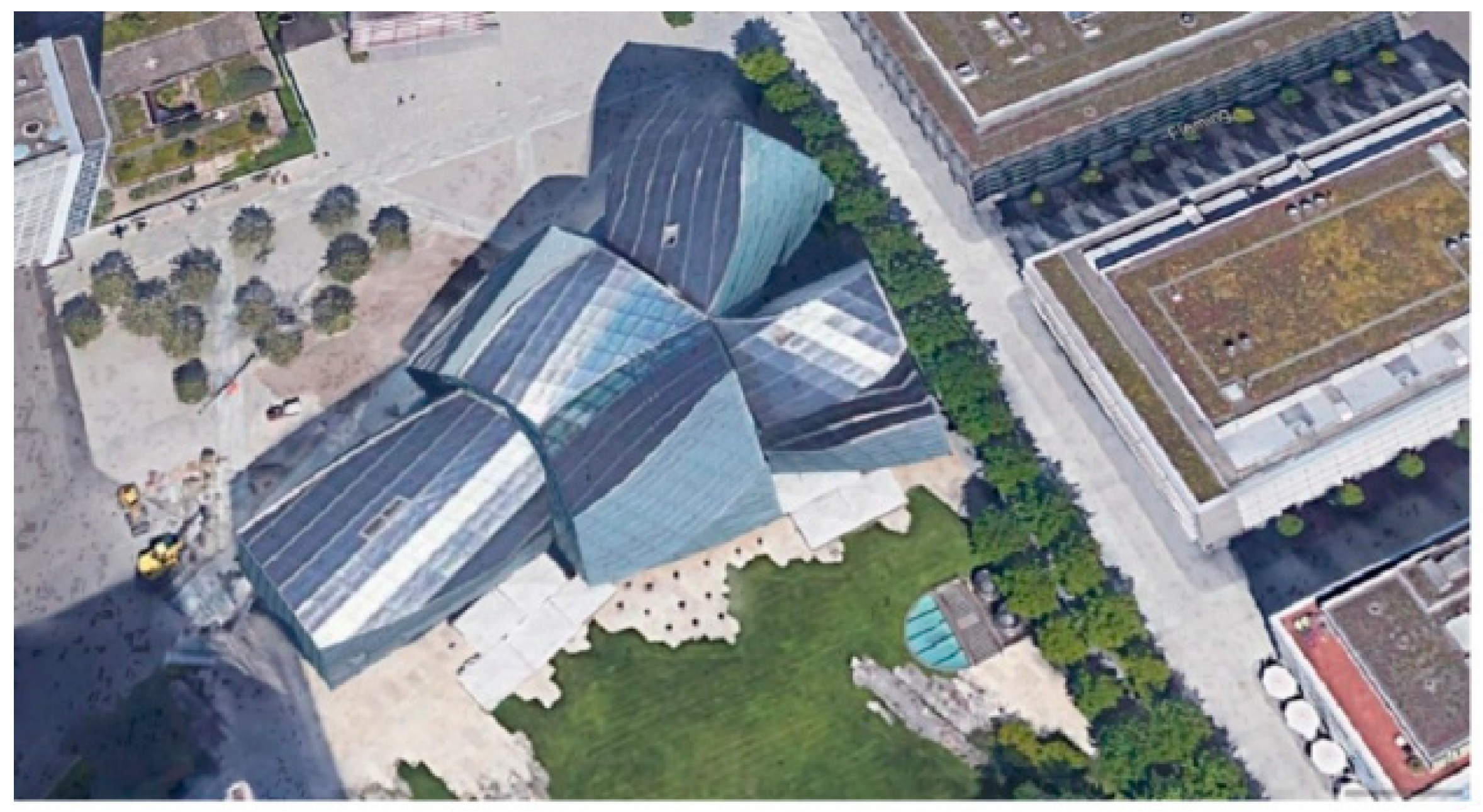
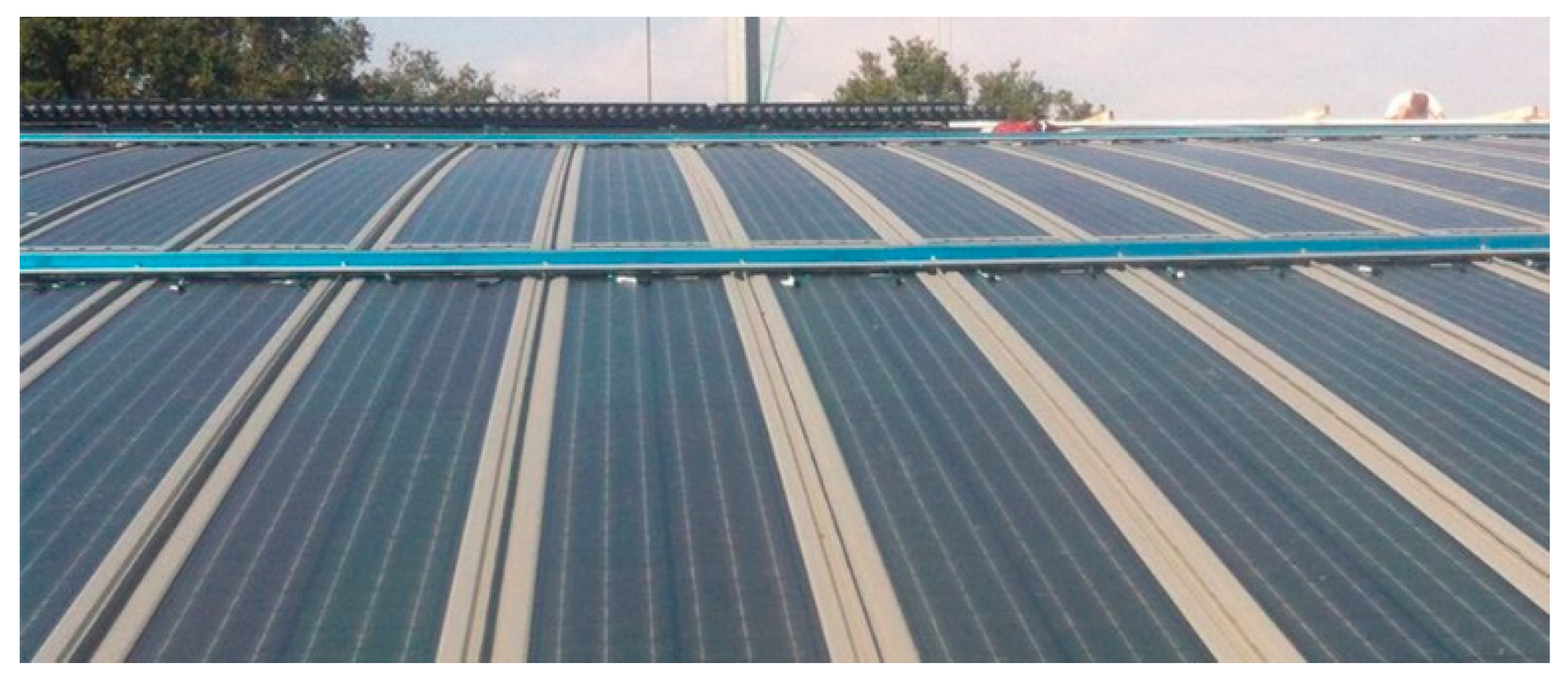
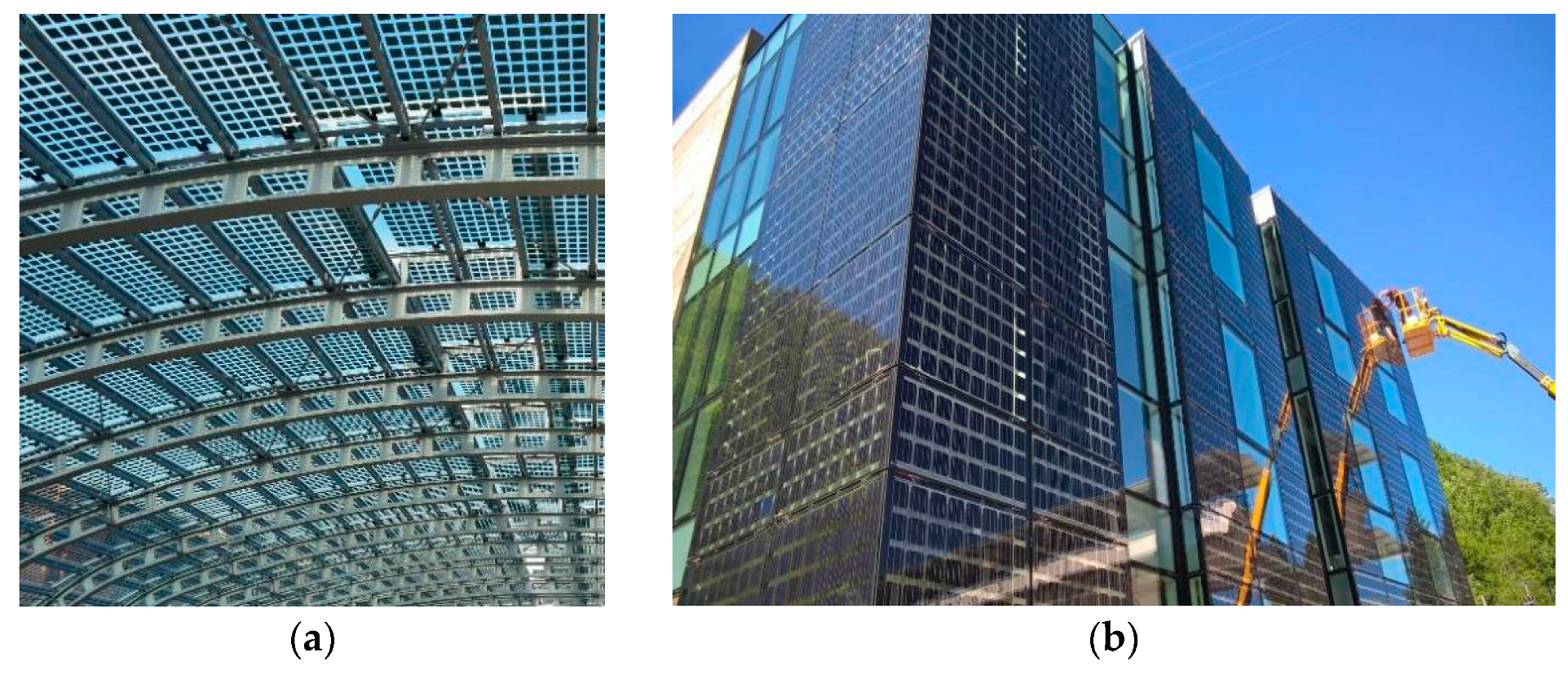

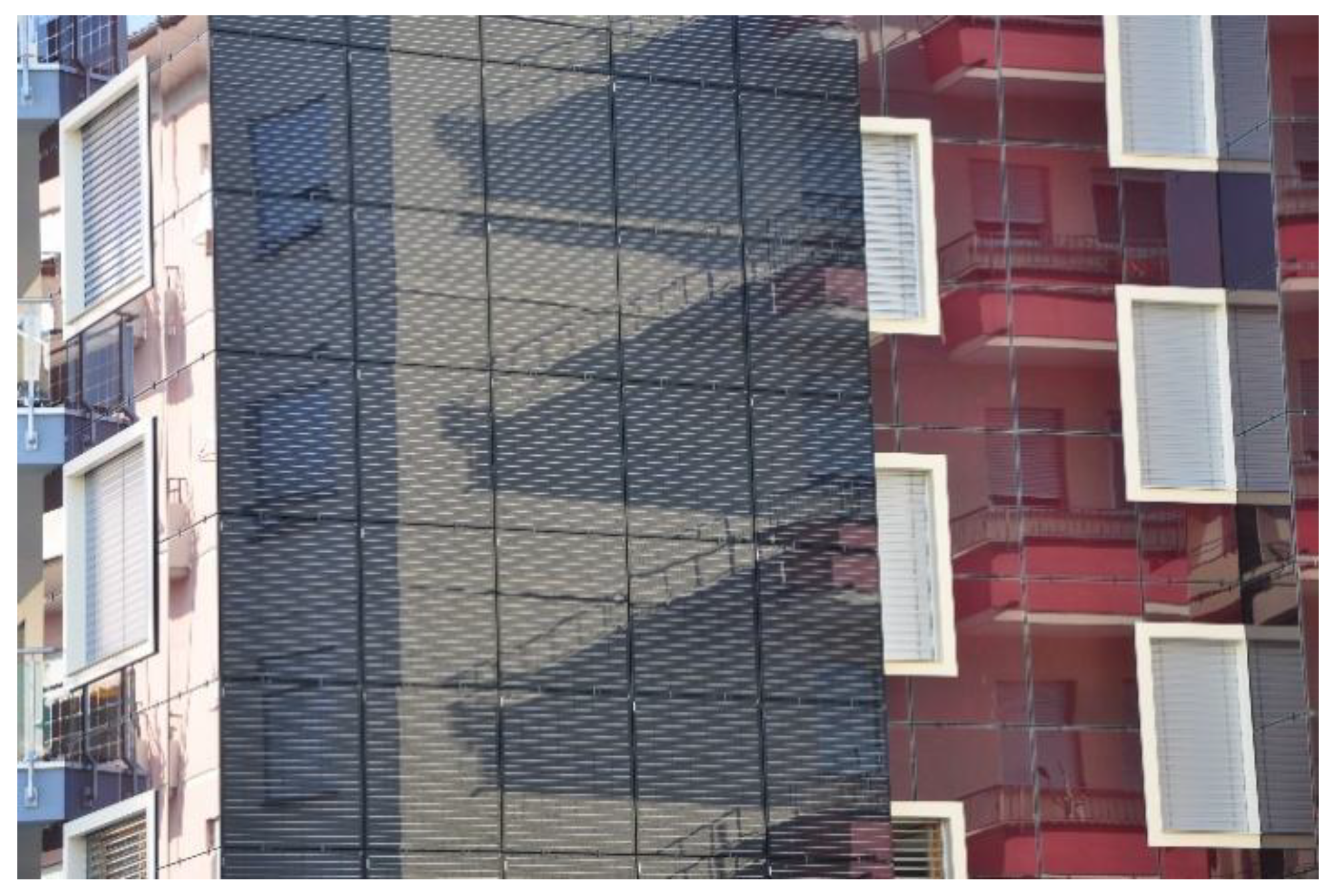


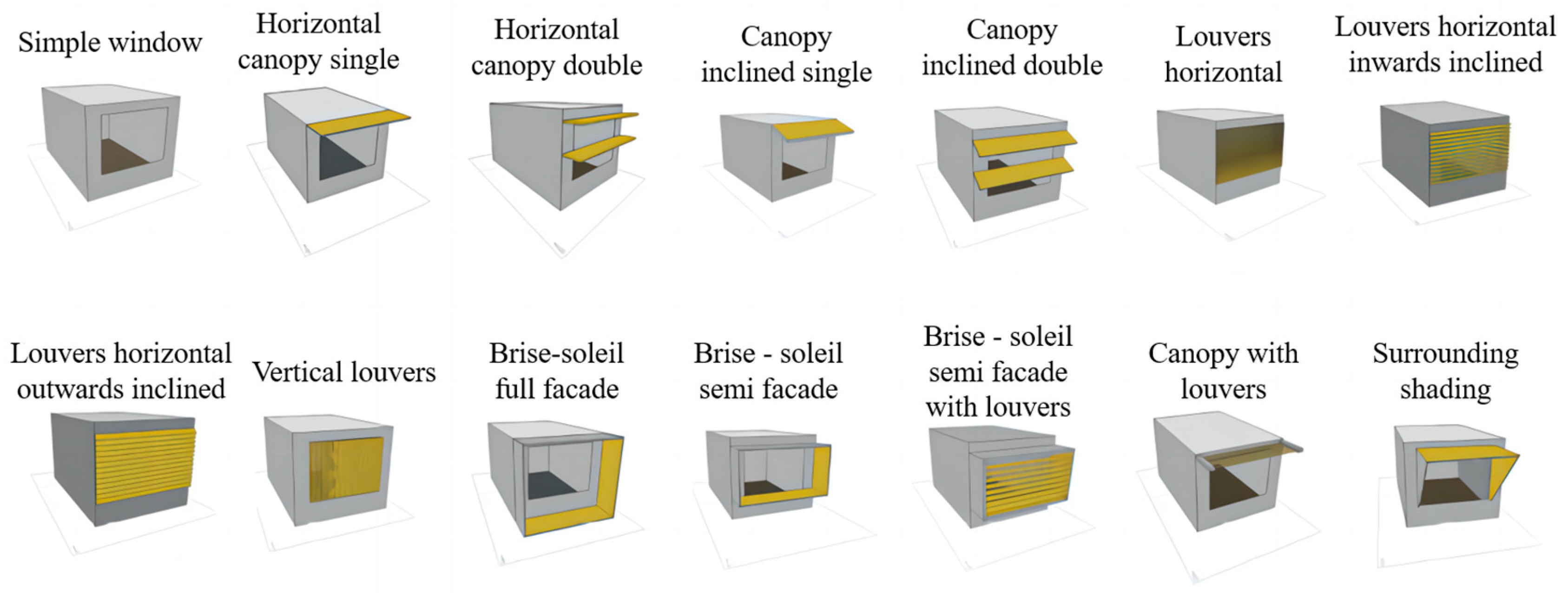

| Characteristics | PV (For Buildings, i.e., BAPV) | BIPV | References |
|---|---|---|---|
| Support | Traditional framework module support | Without the support | [10] |
| Function | Can only generate electricity; more resource intensive as construction materials are not replaced | Multifunctional solar product that can both generate electricity and be used as a building material | [10,93] |
| Cost | Lower | Higher (High maintenance costs) | [90,93] |
| Installation | Effortless installation; Mature technology | The installation and maintenance are difficult | [88,90] |
| Temperature influence | less affected by temperature | The performance is greatly affected by temperature | [10] |
| Architectural appearance | Lower priority for esthetic requirements | Architectural esthetics should be considered in the design process, which can play a role in building appearance beautification | [10,30,105] |
| Reduced pollutant emissions (equivalent roof area) | Lower | Higher | [93] |
| Installation area | Roof | Roof, facade, Windows, etc. | [10] |
| PV cell | First-generation PV cells | PV cells range between first and third generation, depending on applicability | [92] |
| PV module electrical efficiency | 10–15% | 6–7% | [30] |
| Characteristics | Shading | BIPV | References |
|---|---|---|---|
| Function | Only the indoor HVAC energy consumption due to solar radiation can be reduced. | In addition to the function of shading, it can also independently generate electricity to provide considerable power for building appliances. | [85,113,114,115,116] |
| Cost | Lower | Higher and has high maintenance costs, due to the need to integrate photovoltaic modules | [93,116] |
| Installation | Simple installation process | More complex, due to the integration of photovoltaic cells, additional installation of electrical circuits, as well as power supply and control equipment, is required. | [95,116,117] |
| Reduced energy consumption | Reduce HVAC energy consumption by 1–37% | In addition to reducing HVAC energy consumption, it can provide approximately 62% of the electricity to the building. | [85,113,114,115,116] |
| Location | Climate Type | Brief Introduction of Building | Location of the BIPV in the Building | Renovation Plan—Other Parts of the Building | Energy Performance (After Renovation) | Cost | Ref. |
|---|---|---|---|---|---|---|---|
| Singapore | Tropical rainy climate | 1. Landed house: 3 floors; area of 306 m2; height of 3.5 m. 2. Apartment building: 25 floors | Original installation: Roof After optimizing and assuming simulations, installation in roof, exterior walls, and windows is proposed | NA | Around 240 kWh/m2yr | NA | [121] |
| Brazil | Tropical savanna climate | The study area contains a total of seven public buildings, and 89% of the analyzed buildings were determined to be rectangular. The average building width is 30 m, the average height is 30 m, the surface-to-volume ratio is 0.360, and the roof area/total built area is 0.41. | Roof Facades oriented towards the north, east, and west directions. | NA | 35–55 m2yr | NA | [124] |
| Ticino | Mediterranean climate | Monument Doragno Castle: Transformed from an old medieval castle into a private residence | Roof | Solar energy collector (BIST) is also installed on the roof | 45.62 (kWh/m2yr) | NA | [128] |
| Berne/BE | Temperate continental climate | A single-family Neo-Baroque House | Roof | Install a PV and a solar thermal system and replace a gas heating system heat pump, geothermal detector, and a furnace. | 35.22 (kWh/m2yr) | 1429 CHF/m2 | [128] |
| Japan-Tokyo Minato | Subtropical oceanic monsoon climate | The floor height of 3 m. Set the above-ground window-to-wall ratio for the west, south, north, and east walls at 0.35, 0.4, 0.2, and 0.15, respectively. | Roof After optimizing and assuming simulations: roof, façade, and windows | NA | Facade PV is expected to generate 2.1 GWh per year, similar to photovoltaics generated on rooftops | 33.55 $kW−1·yr−1 | [129] |
| Greece | Site: 4500-hectare parcel in Kallithea-N area Plots: Three independent plots, approximately 42,000 square meters in total Building coverage: Maximum 40% of total plot area | Roof | Gas boiler district heating system, low-temperature DHC network provides heat energy, geothermal heat pumps to heat and cool the DHC network. Single-pane windows are substituted with double-glazed windows featuring aluminum frames. | NA | NA | [130] |
Disclaimer/Publisher’s Note: The statements, opinions and data contained in all publications are solely those of the individual author(s) and contributor(s) and not of MDPI and/or the editor(s). MDPI and/or the editor(s) disclaim responsibility for any injury to people or property resulting from any ideas, methods, instructions or products referred to in the content. |
© 2023 by the authors. Licensee MDPI, Basel, Switzerland. This article is an open access article distributed under the terms and conditions of the Creative Commons Attribution (CC BY) license (https://creativecommons.org/licenses/by/4.0/).
Share and Cite
Kong, J.; Dong, Y.; Poshnath, A.; Rismanchi, B.; Yap, P.-S. Application of Building Integrated Photovoltaic (BIPV) in Net-Zero Energy Buildings (NZEBs). Energies 2023, 16, 6401. https://doi.org/10.3390/en16176401
Kong J, Dong Y, Poshnath A, Rismanchi B, Yap P-S. Application of Building Integrated Photovoltaic (BIPV) in Net-Zero Energy Buildings (NZEBs). Energies. 2023; 16(17):6401. https://doi.org/10.3390/en16176401
Chicago/Turabian StyleKong, Jiashu, Yitong Dong, Aravind Poshnath, Behzad Rismanchi, and Pow-Seng Yap. 2023. "Application of Building Integrated Photovoltaic (BIPV) in Net-Zero Energy Buildings (NZEBs)" Energies 16, no. 17: 6401. https://doi.org/10.3390/en16176401
APA StyleKong, J., Dong, Y., Poshnath, A., Rismanchi, B., & Yap, P.-S. (2023). Application of Building Integrated Photovoltaic (BIPV) in Net-Zero Energy Buildings (NZEBs). Energies, 16(17), 6401. https://doi.org/10.3390/en16176401








